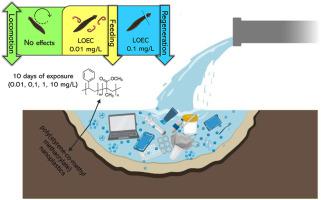Environmental Pollution ( IF 7.6 ) Pub Date : 2023-06-02 , DOI: 10.1016/j.envpol.2023.121959 Giulia Cesarini 1 , Francesca Coppola 2 , Diana Campos 2 , Iole Venditti 1 , Chiara Battocchio 1 , Andrea Di Giulio 1 , Maurizio Muzzi 1 , João L T Pestana 2 , Massimiliano Scalici 1

|
The concentration of nanoplastics (NPs) is expected to increase in aquatic environments thus potentially threatening freshwater organisms through interactions with plastic particles that variously float, circulate in the water column or sink into the benthos. Studies into the mechanisms of any NP effects are still scarce, particularly with respect to the regenerative ability of biota for which there is no recognised model organism. The present study therefore aimed to investigate behavioural and regeneration responses of the freshwater planarian Girardia tigrina after 10 days exposed to along a gradient 0.01–10 mg/L of poly (styrene-co-methyl methacrylate) NPs (∼426 ± 175 nm). Exposure to NPs induced a significant reduction in planarian feeding rate even at low concentrations (LOEC of 0.01 mg/L), while head regeneration was delayed in a clear dose response way (LOEC of 0.1 mg/L for blastema length). Planaria locomotion assessed was not affected. Our results highlight the potential adverse effects of exposure to poly (styrene-co-methyl methacrylate) NPs and show that feeding behaviour and regeneration of a freshwater benthic organism can be indicators of the resulting toxicity. Planarians are becoming widely used model organisms in ecotoxicology and can help to address potential effects of plastic polymers on regeneration.
中文翻译:

纳米塑料暴露抑制淡水涡虫的摄食并延迟再生
纳米塑料 (NPs) 的浓度预计会在水生环境中增加,因此可能会通过与各种漂浮、在水柱中循环或沉入底栖生物的塑料颗粒相互作用而威胁淡水生物. 对任何 NP 效应机制的研究仍然很少,特别是在没有公认的模式生物的生物群的再生能力方面。因此,本研究旨在研究淡水涡虫 Girardia tigrina 在沿梯度 0.01–10 mg/L 的聚(苯乙烯-甲基丙烯酸甲酯)NPs(~426 ± 175 nm)暴露 10 天后的行为和再生反应。即使在低浓度(LOEC 为 0.01 mg/L)下,暴露于 NPs 也会导致涡虫摄食率显着降低,而头部再生以明显的剂量反应方式延迟(胚基长度的 LOEC 为 0.1 mg/L)。涡虫运动评估不受影响。我们的结果强调了暴露于聚(苯乙烯-甲基丙烯酸甲酯)NPs 的潜在不利影响,并表明淡水底栖生物的摄食行为和再生可能是由此产生的毒性的指标。涡虫正在成为生态毒理学中广泛使用的模式生物,可以帮助解决塑料聚合物对再生的潜在影响。









































 京公网安备 11010802027423号
京公网安备 11010802027423号